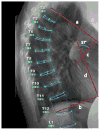Targeted spine strengthening exercise and posture training program to reduce hyperkyphosis in older adults: results from the study of hyperkyphosis, exercise, and function (SHEAF) randomized controlled trial
- PMID: 28689306
- PMCID: PMC5873977
- DOI: 10.1007/s00198-017-4109-x
Targeted spine strengthening exercise and posture training program to reduce hyperkyphosis in older adults: results from the study of hyperkyphosis, exercise, and function (SHEAF) randomized controlled trial
Abstract
A 6-month randomized controlled trial of spine-strengthening exercise and posture training reduced both radiographic and clinical measures of kyphosis. Participants receiving the intervention improved self-image and satisfaction with their appearance. Results suggest that spine-strengthening exercise and postural training may be an effective treatment option for older adults with hyperkyphosis.
Introduction: The purpose of the present study is to determine in a randomized controlled trial whether spine-strengthening exercises improve Cobb angle of kyphosis in community-dwelling older adults.
Methods: We recruited adults ≥60 years with kyphosis ≥40° and enrolled 99 participants (71 women, 28 men), mean age 70.6 ± 0.6 years, range 60-88, with baseline Cobb angle 57.4 ± 12.5°. The intervention included group spine-strengthening exercise and postural training, delivered by a physical therapist, 1-h, three times weekly for 6 months. Controls received four group health education meetings. The primary outcome was change in the gold standard Cobb angle of kyphosis measured from standing lateral spine radiographs. Secondary outcomes included change in kyphometer-measured kyphosis, physical function (modified Physical Performance Test, gait speed, Timed Up and Go, Timed Loaded Standing, 6-Min Walk), and health-related quality of life (HRQoL) (PROMIS global health and physical function indexes, SRS-30 self-image domain). ANCOVA was used to assess treatment effects on change from baseline to 6 months in all outcomes.
Results: There was a -3.0° (95% CI -5.2, -0.8) between-group difference in change in Cobb angle, p = 0.009, favoring the intervention and approximating the magnitude of change from an incident vertebral fracture. Kyphometer-measured kyphosis (p = 0.03) and SRS-30 self-esteem (p < 0.001) showed favorable between-group differences in change, with no group differences in physical function or additional HRQoL outcomes, p > 0.05.
Conclusions: Spine-strengthening exercise and posture training over 6 months reduced kyphosis compared to control. Our randomized controlled trial results suggest that a targeted kyphosis-specific exercise program may be an effective treatment option for older adults with hyperkyphosis.
Trial registration number and name of trial register: ClinicalTrials.gov; identifier NCT01751685.
Keywords: Aging; Clinical trials; Exercise; Radiology; Skeletal muscle.
Conflict of interest statement
Figures



References
-
- Kado DM, Huang MH, Karlamangla AS, Barrett-Connor E, Greendale GA. Hyperkyphotic posture predicts mortality in older community-dwelling men and women: a prospective study. J Am Geriatr Soc. 2004;52(10):1662–1667. - PubMed
-
- Kobayashi T, Atsuta Y, Matsuno T, Takeda N. A longitudinal study of congruent sagittal spinal alignment in an adult cohort. Spine (Phila Pa 1976) 2004;29(6):671–676. - PubMed
-
- McDaniels-Davidson C, Davis A, Wing D, Nichols J, Kado D, editors. J Am Geriatr Soc. 2016. Kyphosis, balance dynamics, and incident falls in community dwelling older adults. - PubMed
Publication types
MeSH terms
Associated data
Grants and funding
LinkOut - more resources
Full Text Sources
Other Literature Sources
Medical
Research Materials

